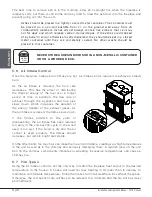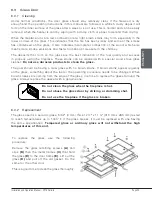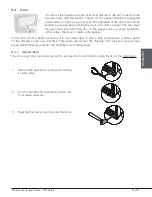
Page 28
Installation and Operation Manual - FP18 Dallaire
ENGLISH
6.4.2 Gasket
Use the correct replacement gasket:
(A)
for the doors and
(B)
for the doors junction. Both can be
purchased from your retailer. The diameter and density of the gasket is important to getting a good seal.
Place the doors face-down on something soft like a cushion of rags or piece of carpet. Remove the old
gaskets from the door by pulling and prying it out with an old screw driver. Then use the screwdriver
to scrape the old gasket adhesive from the door. Now run a 1/4” (6 mm) bead of high temperature
silicone in the door frame gasket groove of the door gasket. Starting from the middle of the hinge side,
press the gasket into the groove. Do not stretch the gasket as you place it. Leave the gasket about
1/2” long when you cut it and press the end into the groove. Tuck any loose fibres under the gasket
and into the silicone. Do the same for center door gaskets. Repeat for the other door. Close the door
and do not use the fireplace for 24 hours.
Location
Length
Dimension
On each door frame
38" (96 cm)
Round 5/8" (16 mm)
Center door gasket
14" (36 cm)
Round 1/4" (6 mm) self-adhesive
6.5 Exhaust System
Wood smoke can condense inside the chimney, forming an inflammable deposit called creosote.
If creosote builds up in the system, it can ignite when a hot fire is burned in the insert. A very
hot fire can progress to the top of the chimney. Severe chimney fires can damage even the best
chimneys. Smouldering, smoky fires can quickly cause a thick layer of creosote to form. When
the insert is operated properly, the exhaust from the chimney is mostly clear and creosote builds
up more slowly.
«Creosote - Formation and Need to Removal
When wood is burned slowly, it produces tar and other organic vapors, which combine with
expelled moisture to form creosote. The creosote vapors condense in the relatively cooler
chimney flue of a slow-burning fire. As a result, creosote residue accumulates on the flue
lining. When ignited this creosote makes an extremely hot fire. The chimney connector and
chimney should be inspected at least once every two months during the heating season to
determine if a creosote buildup has occurred. If creosote has accumulated (
⅛
" [3 mm] or
more it should be removed to reduce the risk of a chimney fire»
Summary of Contents for DALLAIRE FP18
Page 2: ......
Page 6: ...Page 6 Installation and Operation Manual FP18 Dallaire ENGLISH CERTIFICATION PLATE...
Page 69: ......
















































